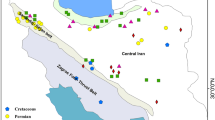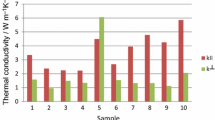Abstract
The basic physical properties of marine natural gas hydrate deposits are important to the understanding of seabed growth conditions, occurrence regularity, and occurrence environment of natural gas hydrates. A comprehensive analysis of the core samples of drilling pressure-holding hydrate deposits at a depth of 1310 m in the Shenhu area of the South China Sea was conducted. The experimental results indicate that the particle size in the hydrate sediment samples are mainly distributed in the range from 7.81 µm to 21.72 µm, and the average particle size decreases as the depth of the burial increases. The X-ray CT analytical images and surface characteristics SEM scan images suggest that the sediment is mostly silty clay. There are a large number of bioplastics in the sediment, and the crack inside the core may be areas of hydrate formation.
Similar content being viewed by others
References
Makogon Y F, Holditch S A, Makogon T Y. Natural gas-hydrates—a potential energy source for the 21st Century. Journal of Petroleum Science and Engineering, 2007, 56: 14–31
Sloan E D, Koh C A. Clathrate Hydrates of Natural Gases. 3rd ed. Boca Raton: CRC Press, 2008
Zhao J F, Guo X W, Sun M R, et al. N2O hydrate formation in porous media: a potential method to mitigate N2O emissions. Chemical Engineering Journal, 2019, 361: 12–20
Dong H S, Zhang L X, Ling Z, et al. The controlling factors and ion exclusion mechanism of hydrate-based pollutant removal. ACS Sustainable Chemistry & Engineering, 2019, 7(8): 7932–7940
Zhao J F, Wang B, Sum A K. Dynamics of hydrate formation and deposition under pseudo multiphase flow. AIChE Journal, 2017, 63 (9): 4136–4146
Ripmeester J A, Alavi S. Some current challenges in clathrate hydrate science: nucleation, decomposition and the memory effect. Current Opinion in Solid State and Materials Science, 2016, 20(6): 344–351
Moridis G J, Reagan M T, Boyle K L, et al. Evaluation of the gas production potential of some particularly challenging types of oceanic hydrate deposits. Transport in Porous Media, 2011, 90(1): 269–299
Zhao J F, Fan Z, Wang B, et al. Simulation of microwave stimulation for the production of gas from methane hydrate sediment. Applied Energy, 2016, 168: 25–37
Song Y C, Kuang Y M, Fan Z, et al. Influence of core scale permeability on gas production from methane hydrate by thermal stimulation. International Journal of Heat and Mass Transfer, 2018, 121: 207–214
Wang B, Dong H S, Liu Y, et al. Evaluation of thermal stimulation on gas production from depressurized methane hydrate deposits. Applied Energy, 2018, 227: 710–718
Zhao J F, Wang J Q, Liu W G, et al. Analysis of heat transfer effects on gas production from methane hydrate by thermal stimulation. International Journal of Heat and Mass Transfer, 2015, 87: 145–150
Feng J C, Wang Y, Li X S, et al. Investigation into optimization condition of thermal stimulation for hydrate dissociation in the sandy reservoir. Applied Energy, 2015, 154: 995–1003
Cheng C X, Zhao J F, Yang M J, et al. Evaluation of gas production from methane hydrate sediments with heat transfer from overunderburden layers. Energy & Fuels, 2015, 29(2): 1028–1039
Zhao JF, Fan Z, Dong H S, et al. Influence of reservoir permeability on methane hydrate dissociation by depressurization. International Journal of Heat and Mass Transfer, 2016, 103: 265–276
Zhang L X, Zhao J F, Dong H S, et al. Magnetic resonance imaging for in-situ observation of the effect of depressurizing range and rate on methane hydrate dissociation. Chemical Engineering Science, 2016, 144: 135–143
Zhao J F, Zhu Z H, Song Y C, et al. Analyzing the process of gas production for natural gas hydrate using depressurization. Applied Energy, 2015, 142: 125–134
Zhao J F, Liu D, Yang M J, et al. Analysis of heat transfer effects on gas production from methane hydrate by depressurization. International Journal of Heat and Mass Transfer, 2014, 77: 529–541
Zhang L X, Kuang Y M, Zhang X T, et al. Analyzing the process of gas production from methane hydrate via nitrogen injection. Industrial & Engineering Chemistry Research, 2017, 56(26): 7585–7592
Song Y C, Wang J Q, Liu Y, et al. Analysis of heat transfer influences on gas production from methane hydrates using a combined method. International Journal of Heat and Mass Transfer, 2016, 92: 766–773
Wang B, Fan Z, Zhao J F, et al. Influence of intrinsic permeability of reservoir rocks on gas recovery from hydrate deposits via a combined depressurization and thermal stimulation approach. Applied Energy, 2018, 229: 858–871
Song Y C, Cheng C X, Zhao J F, et al. Evaluation of gas production from methane hydrates using depressurization, thermal stimulation and combined methods. Applied Energy, 2015, 145: 265–277
Fan Z, Sun C M, Kuang Y M, et al. MRI analysis for methane hydrate dissociation by depressurization and the concomitant ice generation. Energy Procedia, 2017, 105: 4763–4768
Wang B, Fan Z, Wang P F, et al. Analysis of depressurization mode on gas recovery from methane hydrate deposits and the concomitant ice generation. Applied Energy, 2018, 227: 624–633
Wang B, Huo P, Luo T T, et al. Analysis of the physical properties of hydrate sediments recovered from the Pearl River Mouth Basin in the South China Sea: preliminary investigation for gas hydrate exploitation. Energies, 2017, 10(4): 531
Kuang Y M, Yang L, Li Q P, et al. Physical characteristic analysis of unconsolidated sediments containing gas hydrate recovered from the Shenhu Area of the South China Sea. Journal of Petroleum Science Engineering, 2019, 181: 106173
Wu S, Zhang G, Huang Y, et al. Gas hydrate occurrence on the continental slope of the northern South China Sea. Marine and Petroleum Geology, 2005, 22(3): 403–412
Zhang H, Yang S, Wu N, et al. Successful and surprising results for China’s first gas hydrate drilling expedition. Fir in the Ice, 2007, 7 (3): 6–9
Zhou S W, Chen W, Li Q P, et al. Research on the solid fluidization well testing and production for shallow non-diagenetic natural gas hydrate in deep water area. China Offshore Oil Gas, 2017, 29(4): 1–8 (in Chinese)
Lu H, Kawasaki T, Ukita T, et al. Particle size effect on the saturation of methane hydrate in sediments-constrained from experimental results. Marine and Petroleum Geology, 2011, 28 (10): 1801–1805
Shepard F P. Nomenclature based on sand-silt-clay ratios. Journal of Sedimentary Petrology, 1954, 24: 151–158
Gustafsson S, Karawacki E, Khan M N. Transient hot-strip method for simultaneously measuring thermal conductivity and thermal diffusivity of solids and fluids. Journal of Physics. D, Applied Physics, 1979, 12(9): 1411–1421
Liu C L, Meng Q G, Hu G, et al. Characterization of hydrate-bearing sediments recovered from the Shenhu area of the South China Sea. Interpretation (Tulsa), 2017, 5(3): SM13–SM23
Author information
Authors and Affiliations
Corresponding author
Rights and permissions
About this article
Cite this article
Lyu, X., Li, Q., Ge, Y. et al. Fundamental characteristics of gas hydrate-bearing sediments in the Shenhu area, South China Sea. Front. Energy 15, 367–373 (2021). https://doi.org/10.1007/s11708-020-0714-z
Received:
Accepted:
Published:
Issue Date:
DOI: https://doi.org/10.1007/s11708-020-0714-z




